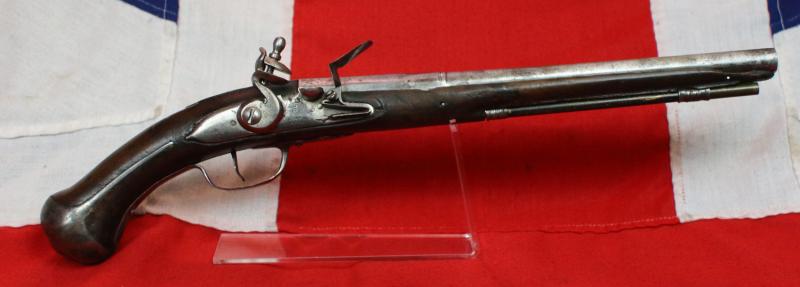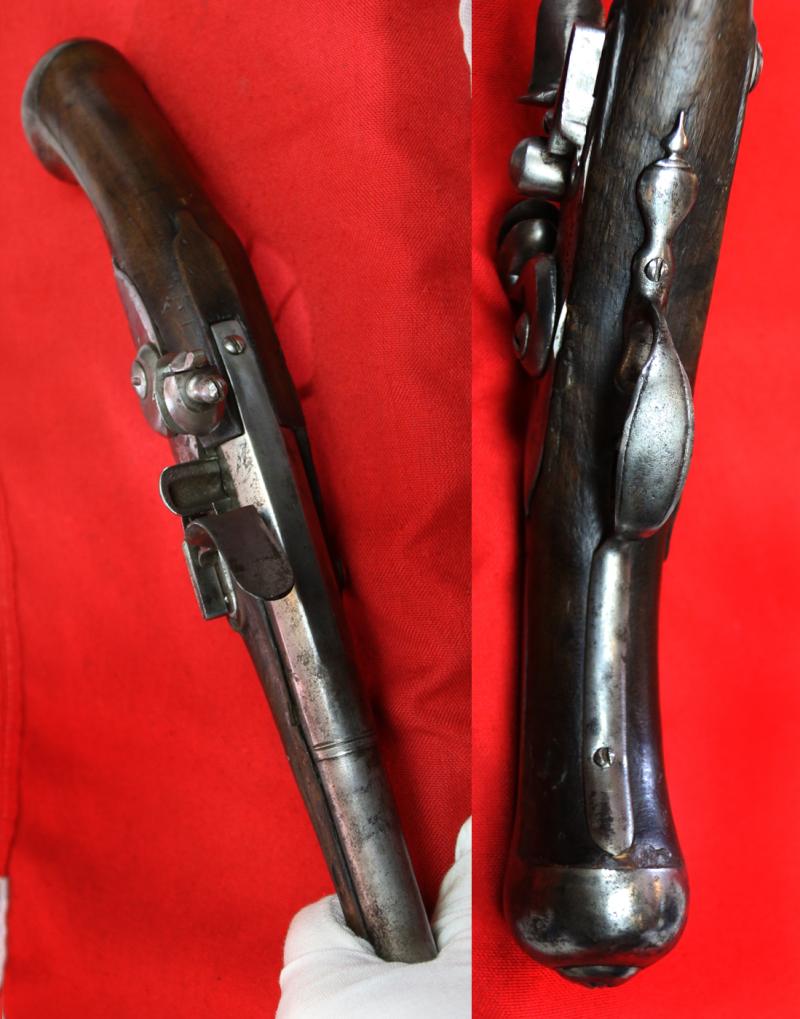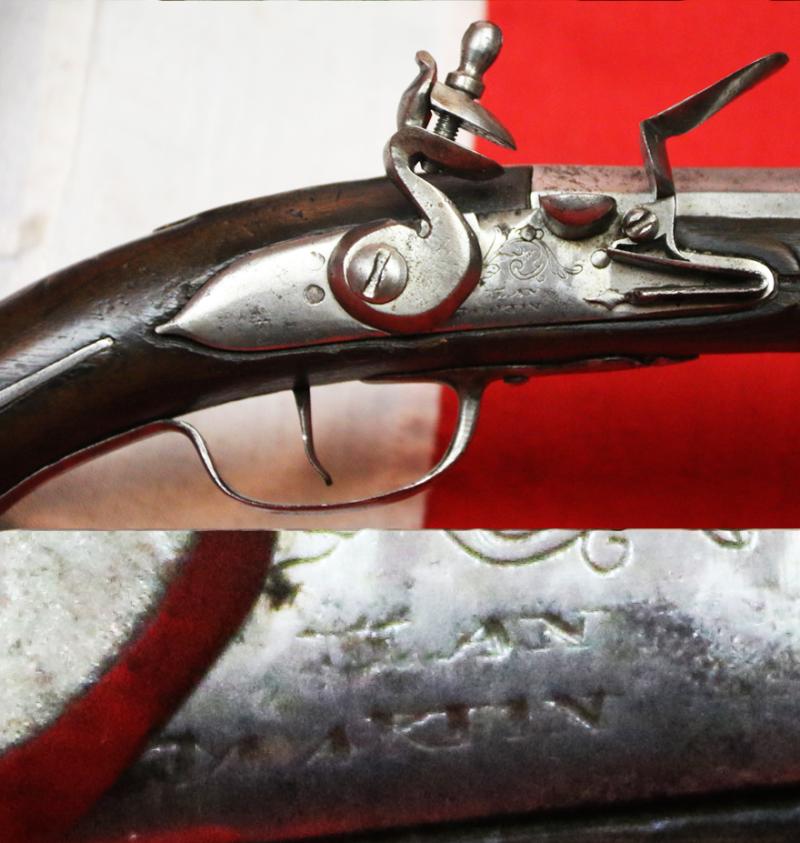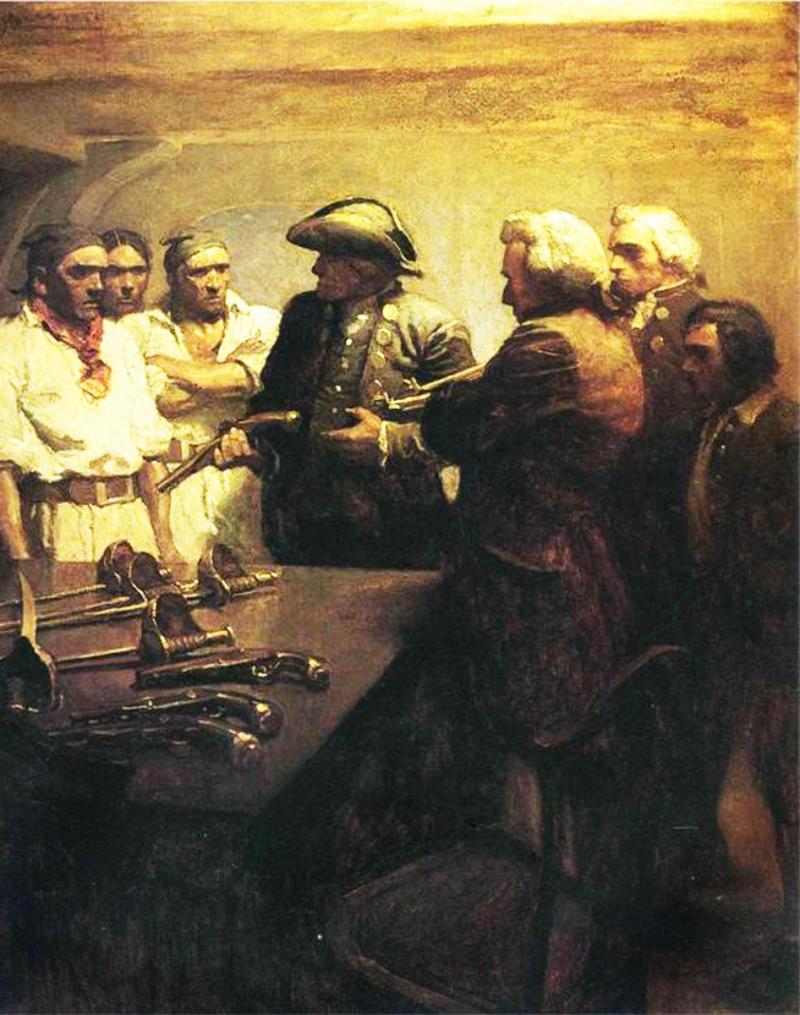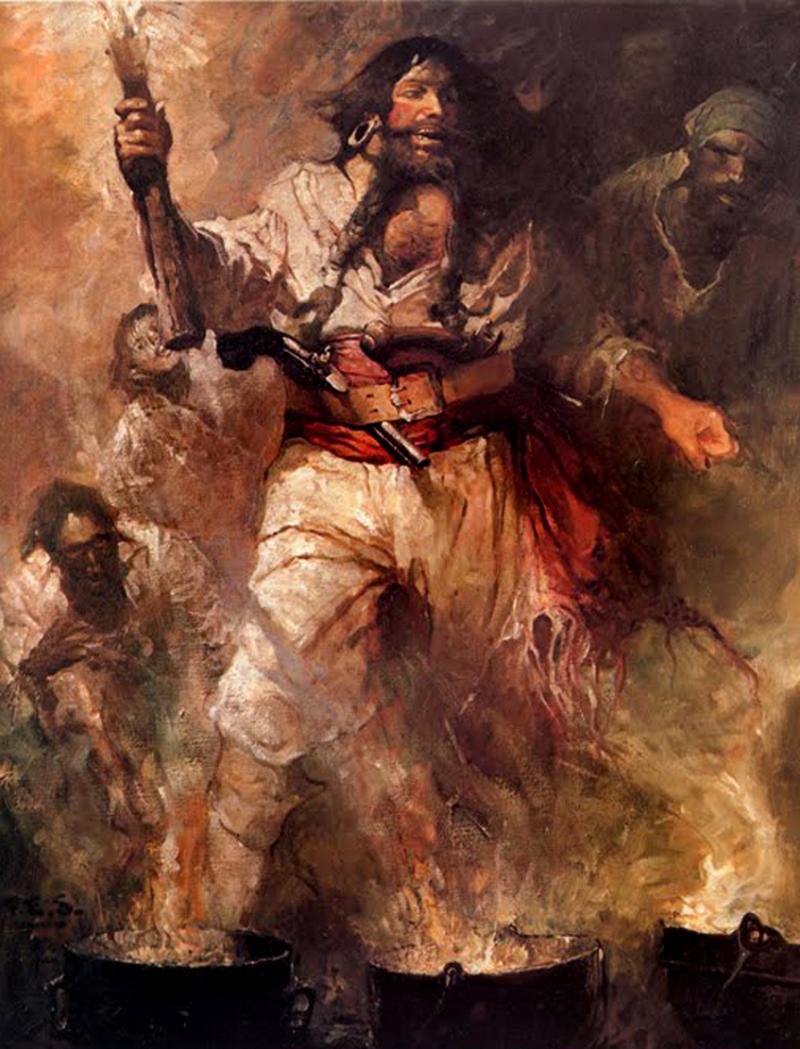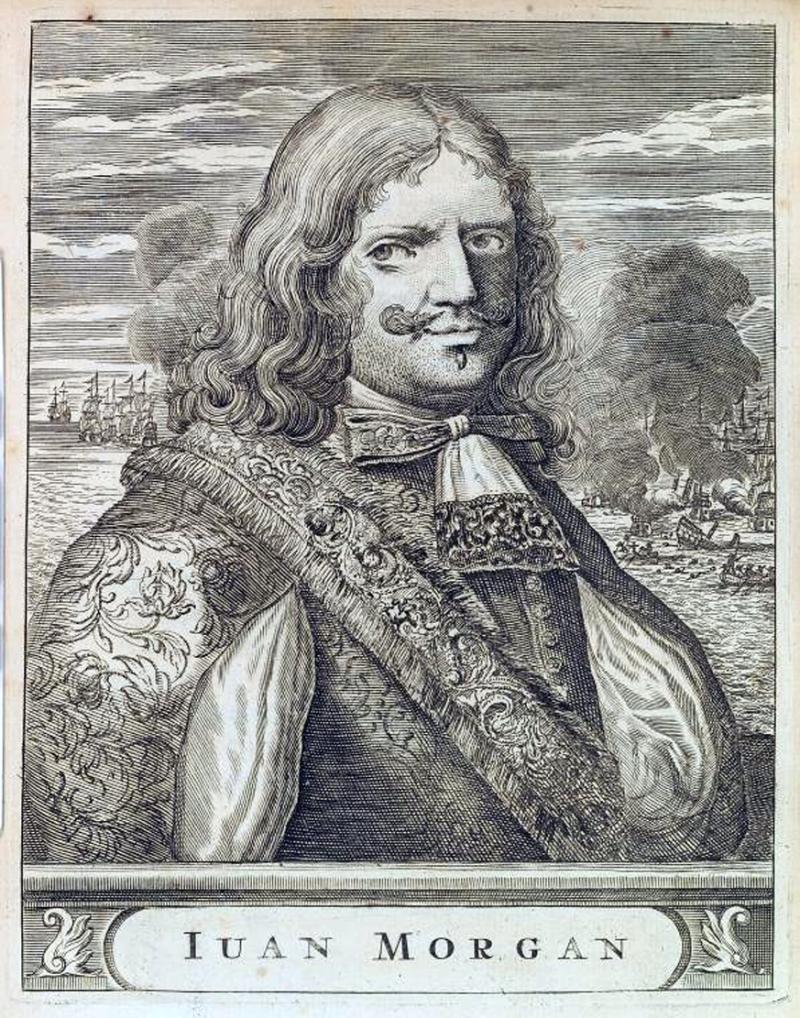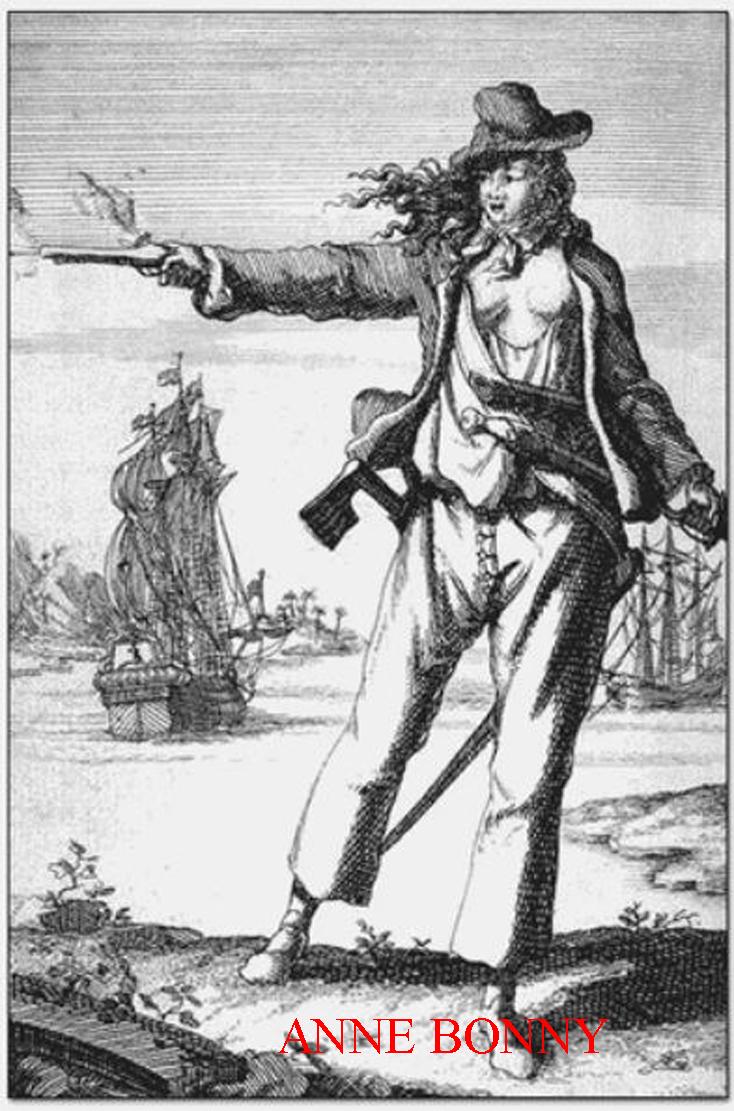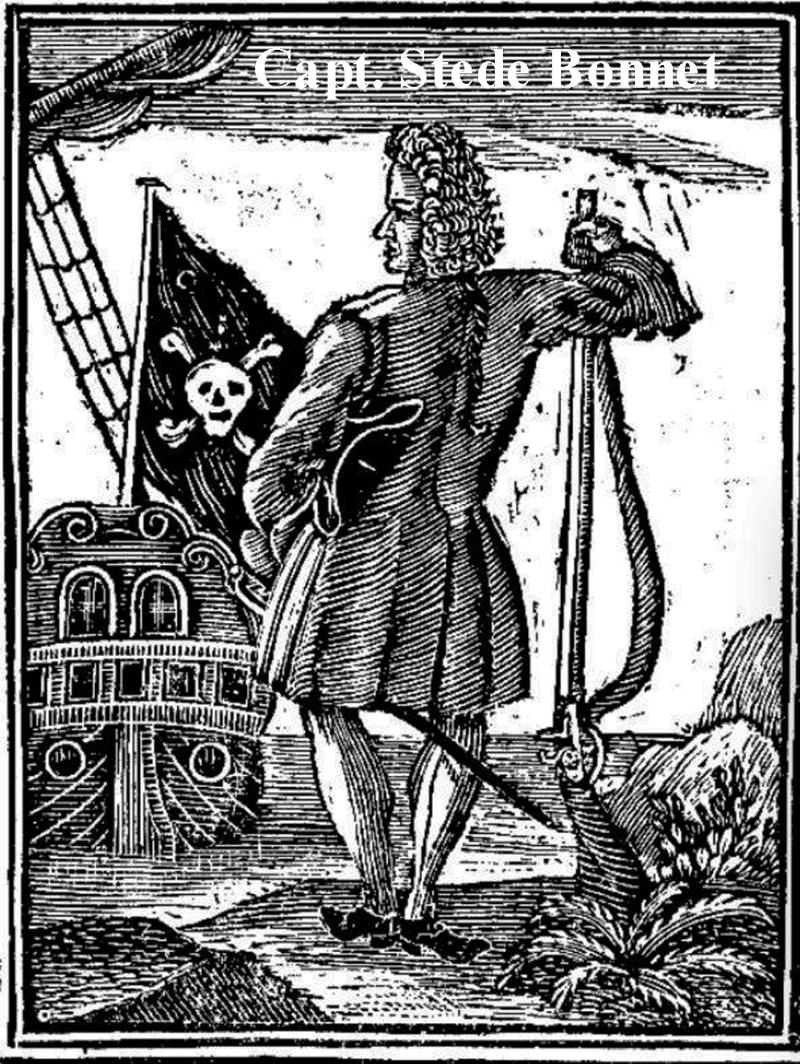A Wonderful, Very Early Period, 17th Century Flintlock Long Buccaneer's 'Fleet Captain's' or Pirate Pistol By Martin of Angers, Anjou, France. From The Real Pirates of The Caribbean & Port Royal Period The So-Called 'Golden Age of Piracy' Circa 1680
An absolute typical and beautiful form of the earliest and most elegant flintlocks of the 17th century, and just as favoured by Pirate Fleet Captains and Buccaneers during the golden age of piracy. Superb walnut stock, earliest form steel mounts, long barrel, and early barrel form ramrod pipes. Long eared steel 'skull crusher' buttcap, and early, typical 17th century 'banana shaped' lock, with florid scroll engraving to the lock plate and engraved with the gunsmiths name, Martin, Angers {Angers is partially obscured through age wear}. Twin nearside lock screws.
Martin is recorded in Angers sometime before 1680 and up to 1710, but his Christian name is not known. Angers was one of the principal provincial gunmaking centres - other significant Angers gunmakers were Boular, Bleiberg, and Pierre Monlong.
In the mid to late 17th century,m in the Western world, the period from the 1680s to the 1720s, has come to be known as the ‘Golden Age’ of piracy.
This was a time of heightened pirate activity, when thousands of ships in the Atlantic and beyond became the prey of roving bands of sea-robbers. Many of the most infamous pirates and buccaneers from history come from this era, Edward 'Blackbeard' Teach, Captain William Kidd, Anne Bonny, 'Calico' Jack Rackham, Henry Morgan, Stede Bonnet and more.
The Caribbean and the east coast of North America were the main areas that saw a surge in activity in the early 1700s. Ships carrying expensive cargoes were often intercepted, and stolen goods were sold in nearby islands and European colonies. Some pirates operated further afield, off the West African coast or in the Indian Ocean, where the island of Madagascar became a key base.
The real Pirates of the Caribbean
"The ‘golden age’ of piracy coincided with the expansion of English, later British, colonial activity around the Caribbean," writes Blyth. "This began in earnest with the capture of Jamaica from Spain in 1655." While piracy has been traditionally portrayed as a male-dominated pursuit, historical evidence suggests that women actively participated in piratical activities during various periods. In the Golden Age of Piracy, from the late 17th to the early 18th centuries, the presence of women in pirate crews became more pronounced. Anne Bonny and Mary Read are two notable examples of women who defied societal norms and navigated the perilous waters of piracy alongside their male counterparts. Their inclusion in pirate crews challenged prevailing gender roles and added a layer of complexity to the maritime lore of the era.
The story of Henry Morgan
Henry Morgan, a British privateer turned pirate, rose to prominence as a cunning strategist and a master of raiding Spanish colonies. Born circa 1635 in Wales, Morgan's early life remains relatively obscure, with scant historical records providing details about his upbringing. His maritime career began as a privateer, authorized by English authorities to harass Spanish colonies and shipping interests in the Caribbean during a period marked by geopolitical tensions between England and Spain.
Sir Henry Morgan was a unique individual in the history of buccaneering. He started out life as an indentured servant on a plantation in Barbados, but worked himself up to become one of the most notorious buccaneers there ever was, receiving not only praise from his uncouth brethren of the coast, but also from his king, who rewarded him with the a knighthood and a lofty position. Morgan had connections running in all levels of society, from the lowest dregs, his mutinous crewmen, to the highest echelons of nobility. Together with his loyal friend and crony, Sir Thomas Modyford, he rampaged the Spanish territories in the Caribbean, his name inspiring fear along the vast coastline of New Spain and its dependencies. Through his network he was able to operate as a broker between criminals from various countries and a nation state, culminating in the biggest amphibious buccaneering raid ever in the Caribbean and the destruction of the once proud city of Panama, of which the ruins can still be visited today. The expected end for a man of his making would be at the gallows, or swinging from the gibbet in some port or another. But not for Sir Henry Morgan. His networking skills protected him, set him up with a respectable position after his career as a buccaneer, and provided him with the luxury of drinking himself to death in the comfort of his own home at the ripe age of 53; a fate most other pirates must have surely envied him for. His exploits in the plunder of Port Royal and the attack on Spanish merchant ships contributed to the era’s rich folklore and became the stuff of legends. Sabatini based the first part of the story of Blood on Henry Pitman, a surgeon who tended the wounded Monmouth rebels and was sentenced to death by Judge Jeffreys, but whose sentence was commuted to penal transportation to Barbados where he escaped and was captured by pirates. Unlike the fictional Blood, Pitman did not join them, and eventually made his way back to England where he wrote a popular account of his ordeal. For Blood's life as a buccaneer, Sabatini used several models, including Henry Morgan and the work of Alexandre Exquemelin, for historical details
The motivations for women to join pirate crews were as diverse as those of their male counterparts. Some, like Anne Bonny and Mary Read, disguised themselves as men to gain access to the adventurous and lucrative world of piracy. Their ability to conceal their gender allowed them to operate freely within the confines of a pirate ship, participating in raids, engaging in combat, and earning the respect of their fellow crew members. The reasons for adopting a pirate's life were multifaceted, often stemming from a desire for economic independence, a rejection of societal constraints, or a quest for personal freedom in an era when opportunities for women were limited.
Original engravings in the gallery of;
Anne Bonny, as pictured in Charles Johnson’s 1724 book A General History of the Robberies and Murders of the most notorious Pyrates. Anne Bonnya (disappeared after 28 November 1720) was a pirate who served under John Rackham. Amongst the few recorded female pirates in the Golden Age of Piracy, she has become one of the most recognized pirates of the era, as well as in the history of piracy in general.
The first biography of Bonny comes from Captain Charles Johnson's 1724 book A General History of the Pyrates. In August 1720, Bonny, Rackham, and another woman, Mary Read, together with about a dozen other pirate crewmembers, stole the sloop William, then at anchor in Nassau harbor, and put out to sea. The crew spent months in the West Indies attacking merchant ships. Bonny took part in piracy alongside the men, handing out gunpowder to fellow pirates, a job usually referred to as a powder monkey. On 5 September 1720, Governor Rogers put out a proclamation, later published in The Boston Gazette, demanding the arrest of Rackham and his associates. Among those named are Anne Bonny and Mary Read
Portrait of Capt. Sir Henry Morgan, as pictured in Alexandre Exquemelin's Piratas de la America (1681) It is probable that in the early 1660s Morgan was active with a group of privateers led by Sir Christopher Myngs attacking Spanish cities and settlements in the Caribbean and Central America when England was at war with Spain. It is likely that in 1663 Morgan captained one of the ships in Myngs' fleet, and took part in the attack on Santiago de Cuba and the Sack of Campeche on the Yucatán Peninsula
Engraving of Capt. Stede Bonnet with a Jolly Roger flag from A General History of the Pyrates (1724) Stede Bonnet (c. 1688 – 10 December 1718) was an English pirate who was known as the Gentleman Pirate because he was a moderately wealthy landowner before turning to a life of crime. Bonnet was born into a wealthy English family on the island of Barbados, and inherited the family estate after his father's death in 1694. Despite his lack of sailing experience, Bonnet decided he should turn to piracy in the spring of 1717. He bought a sailing vessel, the Revenge, and traveled with his paid crew along the Eastern Seaboard of what is now the United States, capturing other vessels and burning other Barbadian ships.
Bonnet set sail for Nassau in the Bahamas, to the haven for pirates known as the "Republic of Pirates", but he was seriously wounded en route during an encounter with a Spanish warship. After arriving in Nassau, Bonnet met the infamous pirate Blackbeard. Incapable of leading his crew, Bonnet temporarily ceded his ship's command to Blackbeard. Before separating in December 1717, Blackbeard and Bonnet plundered and captured merchant ships along the East Coast. After Bonnet failed to capture the Protestant Caesar, his crew abandoned him to join Blackbeard aboard the Queen Anne's Revenge. Bonnet stayed on Blackbeard's ship as a guest, and did not command a crew again until summer 1718, when he was pardoned by North Carolina governor Charles Eden and received clearance to undertake privateering against Spanish shipping interests. Bonnet was tempted to resume his piracy but did not want to lose his pardon, so he adopted the alias "Captain Thomas" and changed his ship's name to Royal James. He had returned to piracy by July.
THE HOME OF ORIGINAL AND AFFORDABLE ANCIENT ANTIQUITIES & ANTIQUE COLLECTABLES IN BRITAIN.
The Lanes Armoury, world renown as Britain's favourite specialist collectors shop, and also a font of historical and educational information that is detailed with every single item. We detail each piece alongside its historical context, either generic or specific, for those that may wish to read, learn, or be informed, as opposed to simply acquire collectable items. It is probably one of the oldest companies of our kind in the whole of Europe and we have been established through generations, as specialists in armoury antiques, militaria collectables, and specialist books, since the early 1900’s, and thus we have continued to be one of the largest in the world today. We are also very pleased to know we are also studied and read by academics and students from hundreds of universities around the world, by those that are interested in not only British but worldwide history.
For this reason we also like to be known as a learning and researching website.
Everyday we are contacted by historians that wish to make contributions to our detailed information for our pieces, and to thus add to our constant dedication to impart historical knowledge, that may be unknown to many of our millions of viewers.
Overall in super condition for age, very nice and crisp action, good steel all over with just minor traces of usual old surface pitting, very small contemporary repairs to the walnut stock with small losses to the forestock wood trim, bottom half of the brass tipped rammer lacking.
19.5 inches long overall.
Every single item from The Lanes Armoury is accompanied by our unique Certificate of Authenticity. Part of our continued dedication to maintain the standards forged by us over the past 100 years of trading
Code: 25750
3250.00 GBP

